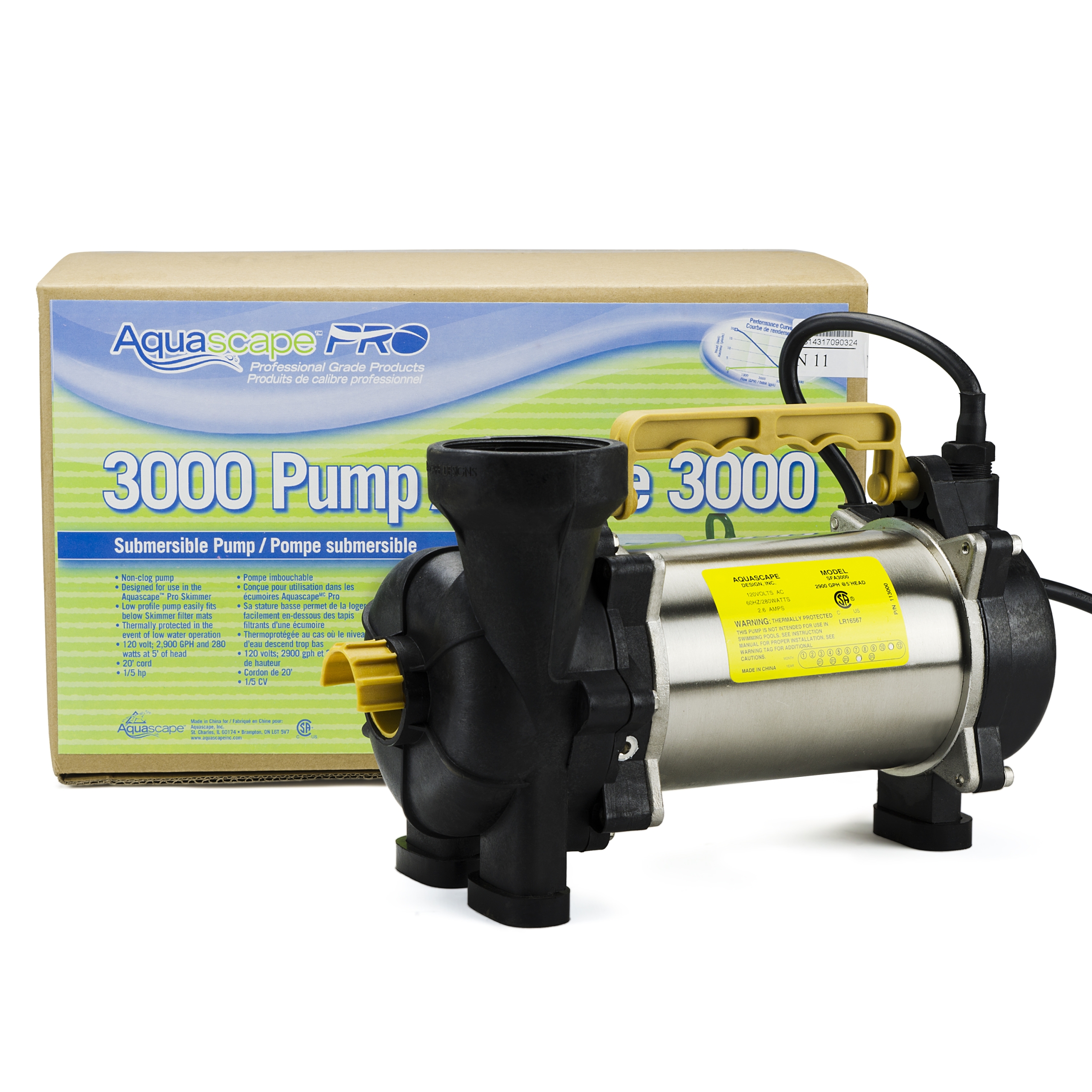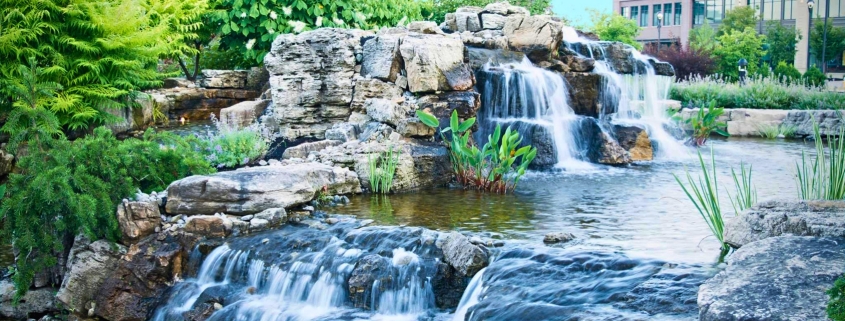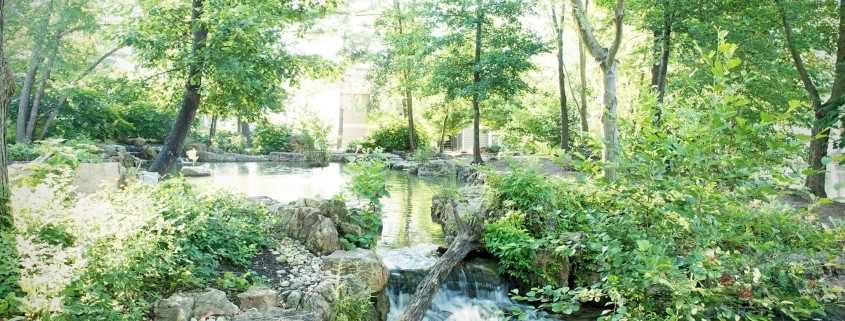Best Pond Pump Information 2021
Pumps keep the water in your pond healthy. They help evenly spread nutrients in the water to fish, plants and other aquatic life. Running water prevents stagnation and cuts down on algae and mosquitoes. Keeping the water moving ensures that oxygen levels are distributed throughout the pond. Pumps also provide power for a pond’s water features, like waterfalls and fountains.
This guide will help you learn about the best pond pumps for your garden.
~
The best water pumps for your pond and its fountain or waterfall come in variety of types and styles. They include submersible, external, magnetic drive and direct drive. Each of these water garden pumps offers its own advantages.
Submersible Pumps: These pumps are designed to work while wholly submerged in water. Typically, they are installed in the deepest part of the pond. Submersible pumps can be placed either directly into your pond or in a skimmer box or pond vault.
- Easy to install.
- Work well in environments that capitalize on a natural setting.
- No need to camouflage the pump.
- Run very quietly so there’s no distracting noise in your garden.
- Submersible pumps can be used to drain your pond, if needed.
- Range in pumping size from 50 to 5,000 gallons per hour.
- Can generate higher energy costs than other pump types.
- For smaller ponds, submersible pumps are generally more economical.
Tip: Some submersible pumps use oil to operate. If the pump seal breaks and leaks harmful oil coolant into the water, fish can be hurt or killed. If you have fish or other aquatic life in your pond, you’ll want to look for a submersible model that does not use oil.
External Pumps: External pumps can move a high volume of water, yet usually have lower energy costs than submersible pumps. They are not as quiet as submersible pumps. They should be placed in a dry location near your pond. External pumps are a lot more complicated to install. However, they are generally more reliable.
- Available as self-priming pumps able to draw their own water.
- Can be loud, disturbing the quiet of your garden.
- Work well for larger ponds that are 1,000 gallons or more.
- Offer long-lasting performance and easy repair.
- Require less routine maintenance than submersible pumps.
Tip: Pumps that are not self-priming can burn out a motor if the power shuts off momentarily and then comes back on. Protect against this by installing a check valve.
Magnetic Drive: In a magnetic-drive pump, an electrical charge creates a magnetic field that causes the magnet on the impeller to rotate and pump water. Since they have no seals to wear out, they require little maintenance. Occasionally, you will need to clean the impeller and its chamber for the most efficient operation.
- Completely sealed. Magnetic-drive pumps do not require lubrication.
- Because they don’t contain oil, magnetic-drive pumps are safer for ponds with fish, since oil leaks don’t occur.
- Don’t generate high head heights. Magnetic-drive pumps are unable to lift pond water vertically, which you might need to supply water to a fountain. They are not the best water pumps for fountains.
- Work best in cleaner environments with little or no debris.
- Highly efficient and cost-effective.
Direct Drive: Direct-drive pumps have an enclosed motor that is powered by electricity, which turns the impeller shaft.
- Achieve significant head height, so they are able to move water vertically. They are among the best water pumps for fountains and waterfalls.
- Typically more expensive to operate.
- Push water rather than pulling it.
- Not easily repaired.
Tip: Some models seal the motor in an oil-filled shell with seals around the cord and impeller shaft. These are risky to use if you have a pond stocked with fish. There is an ever-present danger of water contamination if a leak occurs. Many newer pumps, however, feature alternative lubrication that is safe for fish. Look for oil-free models if you have fish or other aquatic life in your pond.
Pond Pump Calculations
Pond Pump Features
Garden Water Features Unleashed
Garden water features bring a unique blend of nature and artistry to your outdoor space. They have the power to transform any garden into a serene oasis that not only looks stunning but also promotes a sense of tranquility and well-being. Whether you’re working with a small urban courtyard or a sprawling estate garden, integrating water elements can redefine your landscape with both visual and auditory appeal. 💧
Enhancing Your Garden’s Aesthetic
At the heart of every garden water feature is its ability to serve as a focal point that draws the eye and soothes the mind. From elegant fountains to cascading waterfalls, these installations add layers of texture and movement that complement surrounding greenery. The sound of gently flowing water creates an atmosphere of calm, inviting you to pause and savor the moment. The interplay of water with natural light throughout the day offers a dynamic display that evolves with the seasons, keeping your garden continuously enchanting.
Diverse Styles for Every Taste
One of the greatest advantages of garden water features is their versatility. They can be tailored to suit various design themes—from traditional and rustic to modern and minimalist. For example, a classic tiered fountain crafted from natural stone can lend an air of historic charm, while a sleek, contemporary water wall made of glass and metal embodies modern elegance. No matter your aesthetic preference, there’s a water feature that will perfectly align with your garden’s character.
Functionality Meets Sustainability
Beyond their aesthetic appeal, garden water features are designed with functionality and sustainability in mind. Modern installations often incorporate recirculating water systems that maximize efficiency and minimize waste. Energy-efficient pumps, such as those from the Aquascape Ultra series, ensure that your feature operates quietly and effectively while keeping energy consumption low. Coupled with smart filtration systems, these features help maintain clean, clear water that enhances the overall health of your garden ecosystem.
Sustainable water features can also foster a microhabitat that supports local wildlife. By integrating aquatic plants and carefully selected design elements, you can create a balanced environment that attracts birds, beneficial insects, and even small amphibians. This harmonious coexistence of nature and design not only enhances the beauty of your garden but also contributes positively to the local ecosystem.
Creating a Personal Sanctuary
Incorporating a garden water feature isn’t just about the visual appeal; it’s about creating a personal retreat right at home. The soothing sound of water helps reduce stress and encourages mindfulness, making your garden a perfect spot for relaxation, meditation, or even small gatherings with friends and family. Adding subtle lighting, such as low-voltage LED fixtures, can transform your water feature into a magical centerpiece after dusk, enhancing the ambiance and usability of your garden during evening hours.
Final Thoughts
Garden water features are an investment in both beauty and quality of life. They merge art with functionality and sustainability, offering a pathway to a more tranquil and inspiring outdoor living space. Whether you choose a bold statement piece or a subtle accent, the addition of a water element is sure to elevate your garden’s ambiance, inviting you to experience a daily escape into nature’s gentle embrace. 😊
Check out our store for all your water gardening needs! Aquascape products are Aquascape Inc. Certified.
Thanks for reading at Meyer Aquascapes! We hope you’ve enjoyed our post on garden pond design. Please leave a comment below if you liked it or have any questions. We’d love to hear from you! Thanks for stopping by!
Flowing Elegance Outdoors
Outdoor water design is more than just a visual enhancement—it transforms your landscape into a serene haven, blending nature with architectural artistry. As seasons change and daily routines become busier, having a thoughtfully designed water element can provide a refreshing retreat right in your backyard. Let’s explore how outdoor water design can elevate your space and create a lasting impression. 💧
Merging Art and Nature
Outdoor water design starts with the vision of merging art with the natural environment. Whether you’re planning a minimalist water wall, a charming fountain, or a cascading waterfall, the goal is to craft an element that complements your garden’s aesthetic. Water, in its many forms, adds movement and sound to your landscape, inviting tranquility and enhancing the sensory experience. The interplay of light, shadow, and water reflections creates a dynamic scene that evolves throughout the day.
Key Elements of Outdoor Water Design
- Focal Points:
A well-designed water feature becomes the centerpiece of your outdoor space. By selecting a location that naturally draws the eye—such as near a seating area or a pathway—you create a natural gathering point. The gentle sound of trickling water invites relaxation and conversation, making your garden a welcoming retreat. - Material Choices:
The materials you choose play a crucial role in defining the character of your water feature. Natural stone, ceramic, and metal can evoke different moods—from rustic charm to modern sophistication. These materials not only enhance the aesthetic but also ensure durability and longevity, even when exposed to the elements. - Water Flow and Movement:
The sound and rhythm of water are fundamental to outdoor water design. A continuous, soothing flow can mask urban noise and create a peaceful ambiance. Modern pump systems, like the Aquascape Ultra series, offer quiet and energy-efficient operation, allowing you to enjoy a smooth, steady cascade that enhances the overall experience.
Sustainable and Functional Design
Sustainability is a core consideration in contemporary outdoor water design. Energy-efficient pumps, smart filtration systems, and recirculating water are now standard features in many installations. By minimizing water waste and reducing energy consumption, you not only lower your ecological footprint but also create a system that requires less maintenance over time. Incorporating native aquatic plants further promotes a balanced ecosystem, helping to naturally filter and oxygenate the water.
Enhancing Ambiance with Lighting and Landscaping
Strategic lighting is key to extending the beauty of your water feature into the evening. Low-voltage LED lights can be positioned to highlight the contours of your fountain or waterfall, creating a magical interplay of colors and shadows after dusk. This not only adds to the visual appeal but also improves safety and usability during nighttime gatherings.
Landscaping around the water feature is equally important. Incorporate complementary elements such as lush greenery, decorative stones, and ambient seating areas. These additions create layers of visual interest, inviting you and your guests to explore and relax in your outdoor sanctuary.
Final Thoughts
Outdoor water design offers an opportunity to create an immersive environment that harmonizes with nature and reflects your personal style. Whether you’re looking to add a subtle accent or create a bold statement piece, integrating water into your landscape can transform your outdoor space into a captivating retreat. Embrace the art and science behind water design, and let your garden tell a story of elegance, sustainability, and serenity. 😊
Grandeur in Water Installations
Large water installations represent the pinnacle of outdoor design, combining artistic vision with technical precision to create breathtaking, immersive environments. These expansive water features—whether they are grand ponds, cascading waterfalls, or multi-tiered fountains—transform public spaces and private gardens alike into tranquil retreats that celebrate the beauty and power of water. 💧
A Symphony of Design and Engineering
Designing a large water installation is both an art and a science. The process begins with a clear vision: architects and landscape designers work together to create a layout that harmoniously blends water, natural materials, and surrounding landscapes. Engineering expertise then takes center stage to ensure that the installation operates efficiently, safely, and sustainably. Modern technologies, such as high-performance pumps like the Aquascape Ultra series, are integral in maintaining water circulation and oxygenation, which are crucial for sustaining both aquatic life and aesthetic appeal.
Enhancing Outdoor Environments
Large water installations do more than just impress visually—they redefine outdoor spaces. In public parks, urban plazas, and luxury resorts, these features serve as dynamic focal points that draw visitors, encourage community gatherings, and even promote local tourism. For residential settings, a substantial water installation can transform a simple backyard into a personal oasis, providing a serene escape from the hustle and bustle of everyday life.
Moreover, the acoustic ambiance created by flowing water adds a unique sensory dimension to these installations. The gentle roar of a waterfall or the rhythmic dance of cascading water sets a calming backdrop, offering both relaxation and a sense of wonder. Integrating LED lighting further enhances the experience, casting a soft glow that accentuates the movement and texture of the water during nighttime.
Sustainability in Scale
Large water features are designed with sustainability in mind. Energy-efficient pumps, smart filtration systems, and eco-friendly materials are incorporated to minimize environmental impact while maximizing performance. Designers also consider water conservation practices, ensuring that every drop is recirculated and reused effectively. This forward-thinking approach not only reduces maintenance costs but also contributes to a healthier ecosystem by promoting natural water purification processes.
Customization and Innovation
One of the most exciting aspects of large water installations is the ability to customize every element. From the choice of natural stones and plant species to the integration of interactive elements such as motion sensors and sound systems, every detail can be tailored to meet the specific needs of the space. Innovations in water feature design now allow for kinetic installations that respond to weather changes and even the presence of visitors, adding an interactive layer to the experience.
The Impact of Large Installations
Ultimately, large water installations have the power to transform their surroundings. They serve as living sculptures that evolve over time, reflecting the changing seasons and the passage of time. Their impressive scale combined with intricate detailing creates a lasting impression, inviting viewers to pause, reflect, and appreciate the beauty of nature in a dynamic urban context.
Whether you are planning a public project or a luxurious private retreat, investing in a large water installation can elevate your outdoor space to new heights of sophistication and tranquility. Embrace the fusion of art, engineering, and nature, and let the majestic allure of water inspire your next project. 😊
Check out our store for all your water gardening needs! Aquascape products are Aquascape Inc. Certified.
Thanks for reading at Meyer Aquascapes! We hope you’ve enjoyed our post on garden pond design. Please leave a comment below if you liked it or have any questions. We’d love to hear from you! Thanks for stopping by!



 Meyer Aquascapes
Meyer Aquascapes
 Meyer Aquascapes
Meyer Aquascapes
